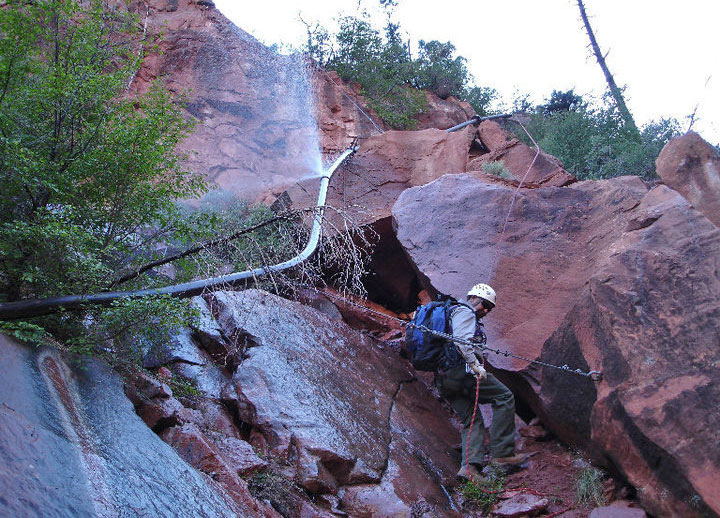 VIEW LARGER The Trans-Canyon Waterline, which brings water from Roaring Springs on the North Rim of the Grand Canyon to the South Rim, needs repairs every year. In this 2014 photo, National Park Service personnel assess a split in a section of the pipe.
VIEW LARGER The Trans-Canyon Waterline, which brings water from Roaring Springs on the North Rim of the Grand Canyon to the South Rim, needs repairs every year. In this 2014 photo, National Park Service personnel assess a split in a section of the pipe. By Rio Yamat, Associated Press
Visitors won’t be able to stay overnight in hotels at Grand Canyon National Park after a series of breaks in the only pipeline that serves the popular tourist destination.
The restrictions will run throughout the Labor Day holiday when hotels are near or at capacity, Grand Canyon spokesperson Joelle Baird said Wednesday. It's an unprecedented move, even for a waterline that has experienced frequent failures, including four recent significant breaks.
The 12 1/2 mile-long (20 kilometer-long) Transcanyon Waterline, originally built in the 1960s, supplies potable water for facilities on the South Rim and inner canyon. Park officials say it has exceeded its expected lifespan, and since 2010, there have been more than 85 major breaks that have each disrupted water delivery.
All park concessions will halt overnight accommodations including at El Tovar, Bright Angel Lodge, Maswik Lodge, and Phantom Ranch. Hotels located outside the park in the town of Tusayan, Arizona, will not be impacted.
Heidi Zahner Younts, of Iowa City, Iowa, said Wednesday in a comment on the park's Facebook page that she had “the trip of a lifetime” with her daughter planned for the weekend, calling the situation sad.
On Wednesday evening, however, she told The Associated Press via Facebook message that she was able to book a different hotel outside the park.
“Maybe less traffic and people?” she said.
The park will remain open for use during the day, as well as the North Rim’s Grand Canyon Lodge and other North Rim visitor services.
Since July 8, officials said, the park has faced challenges with its water supply, and no water is currently being pumped to either the canyon’s south or north rims.
Park officials hope to restore full operational status for overnight guests on the South Rim as quickly as possible.
In the meantime, under the current water restrictions, officials are asking residents and visitors to help conserve water by limiting showers to five minutes or less, turning off faucets while shaving or brushing teeth, flushing toilets selectively, and washing laundry only with full loads.
Complicating restoration efforts is that the breaks occurred in a narrow part of the canyon known as “the box," an area susceptible to rock fall and high temperatures this time of the year.
“It's definitely a challenging place to be and have a pipeline break on you," Baird said, noting safety concerns for the crews tasked with repairing the damage.
The National Park Service recently started construction on a $208 million rehabilitation of the waterline and upgrades to the associated water delivery system that is expected to be completed in 2027.
The park wants to meet water supply needs for 6 million annual visitors and approximately 2,500 year-round residents, officials said.
Associated Press journalists Walter Berry in Phoenix, Felicia Fonseca in Flagstaff, Arizona, and Lisa Baumann in Bellingham, Washington, contributed to this report.

By submitting your comments, you hereby give AZPM the right to post your comments and potentially use them in any other form of media operated by this institution.